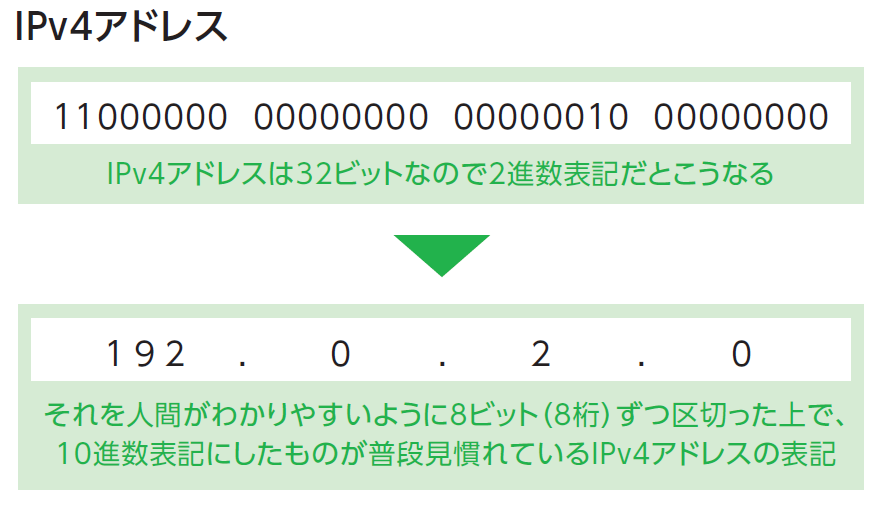open all section menu
close all section menu
- + Preface
- + Chapter1 Resource Management and Registry
- + Chapter2 Resource management before JNIC and JPNIC
- + Chapter3 Restructuring toward fully-fledged resource management by JPNIC
- + Chapter4 Transition of resource management policy for domain names
- + Chapter5 IP address policy in the fully-fledged Internet age
- + Chapter6 Building the global IP address management structure
- + Chapter7 Framework for global domain name management led by ICANN
- + Chapter8 General-use JP Domain Name and establishment of JPRS
- + Chapter9 “Publication” and “disclosure” of registration information
- + Chapter10 IPv4 address pool exhaustion and IPv6
- + Appendix1: IP address and domain name
- + Appendix2: Transition of Internet resource management
- + About History Compilation Team
- + Revision history

Appendix1: IP address and domain name
Format of IP address
Format of a domain name
Each element of a domain name separated by [.] is called a “label.” The maximum length of each label is 63 characters, and a full domain name can have a maximum of 253 characters. Alphanumeric characters and hyphens can be used in labels, but a domain name must not commence or end with a hyphen. Further, uppercase and lowercase letters are treated as equivalent. The right-most label conveys the “top-level domain (TLD),” and the second label from the right represents the “second level domain.” A label to the left of the second level domain is called the “third level domain”, and there can be fourth, fifth, etc. level domains.
DNS (Domain Name System)
The DNS is the system to associate IP addresses, which are easily processed by computers, to domain names, which are comprehensible to people. It is the equivalent of the address book for the Internet. Conversion of an IP address into a domain name, or vice versa, using the DNS is called “name resolution.”

The DNS forms a hierarchical structure, looking like a tree upside down (tree structure), with the top part called the “root” ([“ “] in the figure) and the space extending down to lower hierarchies. In this root space (the root zone), there is a DNS server called the root server, which has information on the manager of each TLD. Beneath the root, TLDs such as .com and .jp are allocated, and DNS servers for managing each TLD are placed. This works in a similar way for the second level domain, the third level domain and so on. Multiple domain names with the same label cannot exist in a given domain, so uniqueness is ensured across the entire space.
gTLD (Generic Top Level Domain)
Some domain names can be registered by anyone from anywhere in the world with no particular limitation, while others have certain conditions for registration. For example, a specific industry may be defined to be eligible to register a name under a particular domain. Examples of the former are .com, .net, .org and so on, and the latter applies to .edu, .pro, .museum and so on. The number of gTLDs as of September 2013 was 22, then a large-scale request for gTLD proposals commenced in 2012. New gTLDs have been added since October 2013, and the number exceeded 570 as of April 2015. Further additions will continue to be made in the future, and it is expected that more than 1,300 gTLDs will be added in the end.
ccTLD (Country Code Top Level Domain)
A ccTLD is a TLD allocated to each country or territory based on a two- letter code stipulated in ISO-3166-1 alpha-2 of the International Organization for Standardization (ISO), and it is based on the country code (two letters) of ISO 3166-1. There are 299 ccTLDs (including Internationalized Domain Names (IDNs)) as of April 2015. Management policy of ccTLDs is determined at each TLD, so some ccTLDs will accept registrations from anywhere in the world, while the others limit registration to entities located in their country or territory such as .jp.
JP domain name
The ccTLD for Japan, .jp, consists of four types: Organizational Type JP Domain Name, Geographic Type JP Domain Name, General-use JP Domain Name, and Prefecture Type JP Domain Name.
| Type | Eligibility criteria | Example | |
|---|---|---|---|
| General-use JP Domain Name | Any individual, group or organization that has an address in Japan | example.jp | |
| Organizational Type JP Domain Name | |||
| co.jp | Corporation body such as a stock company or limited company | example.co.jp | |
| or.jp | Incorporated foundation, incorporated association, union organization, etc. | example.or.jp | |
| ne.jp | Network service | example.ne.jp | |
| ac.jp | University, etc. | example.ac.jp | |
| ad.jp | JPNIC member, network management organization, etc. | example.ad.jp | |
| ed.jp | Kindergarten, elementary school, junior high school, high school, etc. | example.ed.jp | |
| go.jp | Government agency, independent administrative agency, etc. | example.go.jp | |
| gr.jp | Voluntary group organized by multiple individuals or corporations | example.gr.jp | |
| lg.jp | Ordinary local public agency, special district, etc. | example.lg.jp | |
| Geographic Type JP Domain Name | |||
| General Geographic Type Domain Name | Organization that complies with requirements of another category of Organizational Type JP Domain, individual who lives in Japan and hospital | example.shinjuku.tokyo.jp | |
| Local Public Agency Domain Name | Ordinary local public agency and its institution, special district and its institution | metro.tokyo.jp | |
| << Chapter10 | Ver.1.0-April 2015 | Appendix2 >> |




